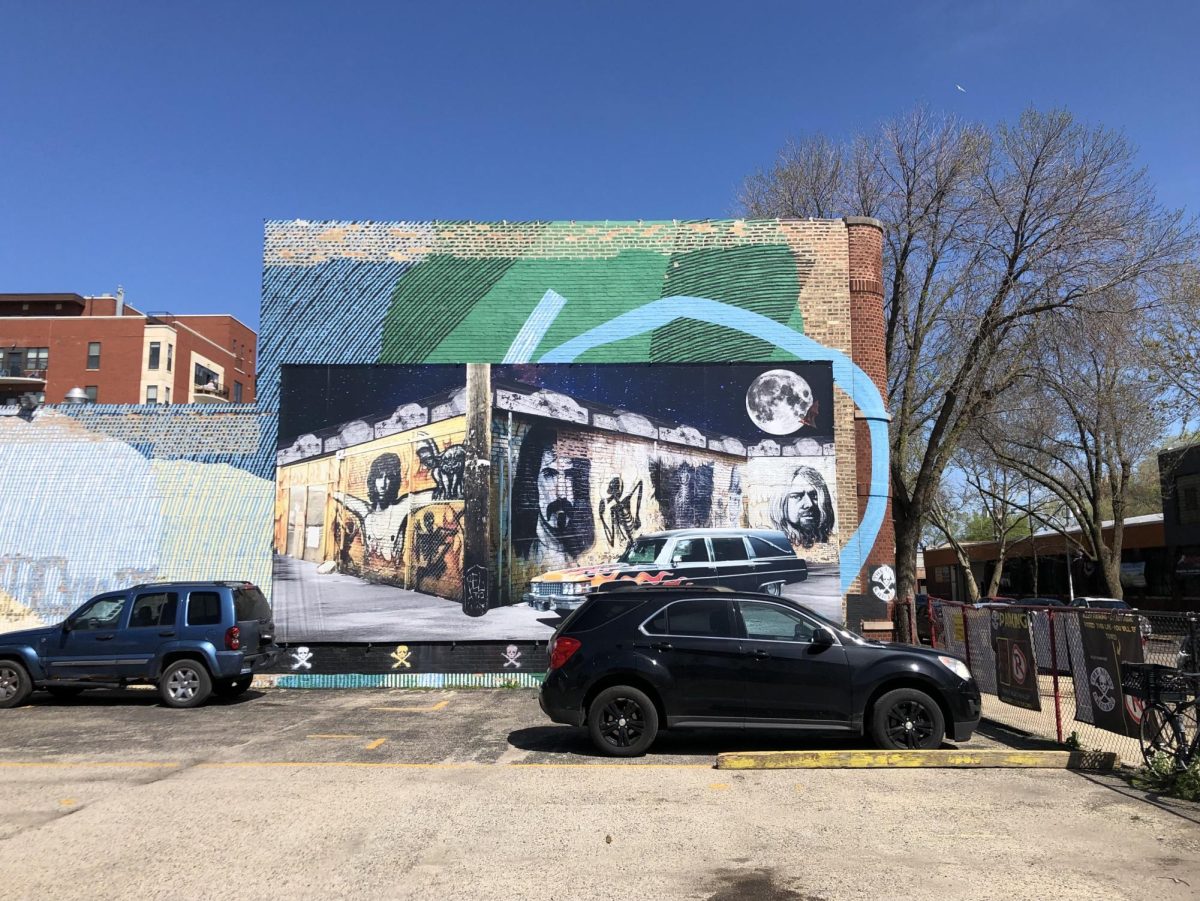Fletcher Street in Avondale, Chicago is the postcard image of residential America, with pastel houses with porches and symmetrically parked SUVs. It is the postcard image, that is, except for the terracotta brick complex halfway down the street. Life-size plastic skeletons climb on its black, iron-bar windows, and a gargoyle with demonic horns and a chain necklace overlooks the entrance from the roof. Welcome to The Alley, a “safe space for weirdos, freaks, misfits,” per its front door. Enter if you dare.
Inside, it is hard to know where to look. Silver pendants hang from the walls. Baskets overflow with crystals. Dracula dolls “with official death certificate” lie in casket-shaped boxes atop the shelves. Racks of leather jackets extend endlessly. Pride pins and metal band patches decorate the counter as a banner depicting Led Zeppelin’s Mothership flies above a red pipe. That’s only the first room. The second is inaccessible, as there’s a sale today. Goths, punks, and other rock fans are packed in there, battling to get a discounted pair of the chunky Demonia platform boots displayed on the wall.
Stuck between two racks of kilts and Tripp pants, I am so stressed. Not because of the second room’s well-meaning, constantly apologizing crowd, with whom I share music and fashion tastes, but because I am about to interview Mark Thomas, The Alley’s legendary founder. “Do you have his phone number?” the cashier casually asks while managing the black-clad line.
A goth employee with facial paint opens an “Employees only” door and guides me down the corridor to Thomas’s office. As a student-journalist, interviews always intimidate me. Added to the mix today are the facts that I am a metalhead and Mark has dressed and embodied alternative subcultures in Chicago for the last 50 years while working with the likes of the Rolling Stones and Black Sabbath.
Mark, slightly limping, welcomes me with a smile and keen eyes.
In his office, a Kiss portrait made of multicolored paint splashes watches over us. As the room warms up, Mark rolls up the sleeves of his The Alley sweatshirt, revealing a tattoo of an American flag crowned with the words “We the People” spreading over his right forearm. When asked about his motivation, he emphasizes this sole touch of color in his black-and-silver outfit by gesturing toward the tinted glass window above my head. I turn around, realizing that, from the office, he can observe the store’s life play out. Customers are still pressed against each other, trying on Demonia as vendors zigzag with shoe boxes in their hands.
Mark is decorated with jewelry, from silver biker rings to a lone earring to bracelets that melodically collide as his hands move to accompany his words. It makes sense for someone who started The Alley in the early ’70s by buying a jewelry factory as a high school junior. The price, roughly $2,000 at the time, came from U.S. savings bonds that he took from his mother’s drawer, which had been intended to pay for his college education.
With high school friends, Mark made jewelry, peace symbol accessories, and eventually roach clips out of castings. From there, bongs followed, and his biggest customer soon became a store called The Alley in Woodfield Mall. After giving it credit once, the store did not pay him. As a bold 20-year-old, he confronted the suit-and-tie-clad owner by everything on the owner’s desk onto the floor until he received the money. Although he recounts this with a jovial face and his short eyebrows comically raised, it is clear that Mark is not someone you want to upset. Putting this incident aside, the pair became partners until the owner disappeared two years later, leaving Mark to lead and expand The Alley.
It seems that Mark has sold everything, even marble-like gargoyles such as the one that overlooks the printer. “If I couldn’t buy it, I’d go find it. If I couldn’t find it, I’d make it,” Mark jokes. Women-centric erotic toys? Check. Cars? Check. Cigars? Check. Even today, The Alley shares the building with its rentable creative spaces that include 30 art and 70 music studios (such as The Art Colony and The Music Factory). “It wasn’t like we only understood how to do… rock ’n’ roll culture,” he explains.
In fact, The Alley’s specialization in punk-related subcultures seems almost coincidental. The 1979 Model Drug Paraphernalia Act, which restricted the sale of items related to cannabis consumption, forced The Alley to reinvent itself. Encouraged by Mark’s love for Sid Vicious and The Clash, as well as the demand for punk t-shirts, The Alley devoted itself to this subculture.
Mark could have had a very different life. He grew up in a wealthy family and attended the Latin School of Chicago, typically a springboard to an Ivy League school. This trajectory was interrupted when his parents got so caught up in their divorce proceedings that his tuition was not paid, and he had to leave for a cheaper Catholic school. Lacking money for clothes and shoes, he started hustling, buying and selling goods on the street. “We say we were born with a silver spoon in our mouths. They took the silver spoon out, and then they knocked out our front teeth,” he says of his siblings and himself, mimicking a punch.
Critics have blamed him for commercializing punk. But there is more to it than money; otherwise, he would not still be here, 50 years and more than 15 surgeries later.
Behind the tinted glass, a silver-haired man in a blue polo shirt waits for a teenage girl to try on a pair of colorful Demonia shoes. Mark points at them and smiles: “A kid used to get in trouble for going to The Alley, because we were the evil place and the devil-worship place. Now the parents are bringing their kids back and sharing the experience they had in The Alley.” It means a lot to Mark to see these young people in the shop who often tell him that their dads are cool, perhaps because they represent an appreciation for alternative lifestyles passed down through generations and promise a future for The Alley.
People, from customers to employees to friends and family, are the reason Mark will continue to supervise The Alley until his health no longer lets him do so. It is also why, at around 70 years old, Mark still comes to his office daily, even if it is only for a couple of hours.
“We built a culture of acceptance of anybody,” he says, citing as an example the fact that The Alley used to be located at Broadway and Surf in Lakeview, home to an LGBTQ+ neighborhood, and was integrated within that community. More than acceptance, it is a culture of supporting others, whether that means donating clothing to nonprofits or using The Alley’s social media to promote local record stores. But Mark worries whether this culture will carry on. “I want to make sure I protect my legacy,” he says after a pause, his eyes returning from the past to meet mine.
Almost every major rock band you can think of can be tied back to The Alley and to Mark. The store’s visitors include “all the bands who really mean anything as they come through Chicago,” spanning countless subgenres and artists, from Rob Zombie to Ministry.
The Alley’s larger-than-life legacy has itself become a burden of sorts for Mark in his quest to find a successor. The ideal candidate would need to be “committed to the lifestyle to not destroy what the business is,” he says. “If I find somebody that understands retail, are they [going to] understand t-shirt printing? Are they [going to] understand jewelry casting?”
Currently, Mark is trying to streamline The Alley’s different activities to ease the future transition. Does this ideal candidate exist? Mark himself isn’t sure. “I don’t want my store to die, so I’m looking for the right person… and that may be an impossible thing to find; that may be difficult,” he says.
The Trump administration’s tariffs on imports, and especially the tariffs on Asian countries, have added a layer of worry to Mark’s perception of The Alley’s future as a small business: “All of our clothing would be gone; the shoes would be gone. I mean, they would still be here. But is anybody [going to] pay that price? I don’t think so.”
Mark takes me on a tour of the store, which has now returned to a calmer Saturday activity level after the last pairs of Demonia have been sold. “I consider those people that are walking around this store my extended family, and some of them are my close personal friends. I don’t want them to ever not have the privilege of walking into a store like this,” he says.
I understand his worry. We have been circling around the theme of legacy for the last hour and a half. Our whole exchange has been part of preserving the legacy of him and the store, a burden that now partially rests on my shoulders. Subcultures need spaces to blossom, and The Alley is one such place, separate from the deafening concert venues and bars. Where would we encounter people who also come to life through this music—our music—if we woke up to find these places gone? Would our community survive if these stores, which helped shape our initial identity and soundtrack, disappeared?
As we return to the “Employees only” area, Mark takes out an imposing key ring. The Alley’s guardian sorts through the keys, trying to find the one that will take me to the beginning—the original jewelry factory. Once the door opens, the soft light guides Mark to a basket full of unfinished belt buckles behind a large machine I cannot name and a neighboring t-shirt press. From among the rough silver metal, he picks two and gently hands them to me, saying he wants me to keep a souvenir from today.
In the menacing skull over two crossed meat cleavers and the Egyptian ankh with intricate inscriptions I receive, I read the end of an era for The Alley and its associated subcultures, but also the promise of a rebirth. Mark closes the door to the past and turns to me with a grin, his dark brown eyes sparkling: “My life could have been really different.… I don’t regret it. I think I won the lottery.”









